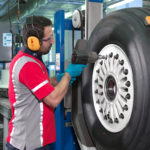General Electric (GE) and Safran have announced plan to test-build an open-bladed jet engine which will cut fuel consumption and emissions by 20 per cent.
The venture is a key step towards the next generation of medium-haul jets and will prolong the US-French CFM International joint venture by a decade to 2050. The “RISE” engine will feature a design with visible fan blades known as open-rotor and could enter service by the mid-2030s. The hybrid-electric propulsion system would be capable of running on 100 per cent sustainable fuel or hydrogen. The engine is being positioned as a possible successor to the “LEAP” model used on the Boeing 737 MAX and some Airbus A320neo. CFM is the sole engine supplier for the Boeing 737 MAX and is the world’s largest jet engine maker by number of units.
RISE engine is fuel “agnostic”
GE Aviation Chief Executive John Slattery told a news conference: “If Boeing or any airframer launches a platform and the business case makes sense for us, then we will present our best aggregate technologies that we have at that moment in time.”
The launch comes as both Boeing and Airbus explore new technologies to reduce emissions, meeting global targets and creating more sustainable travel methods. Airbus, which has unveiled zero-emission concept planes, has welcomed the new engine which is expected to be “agnostic” about the type of fuel.
Rotors placed outside engine to reduce fuel burning
The open-rotor engine concept places previously hidden whirring parts on the outside of the engine to capture more air and reduce the burden on the engine’s fuel-burning core. Noise concerns have hampered previous attempts to develop open-rotor engines.
Safran Chief Executive Olivier Andries told Reuters: “I am very confident we will meet the most stringent noise regulations … and safety requirements.”
Reuters has previously reported that Boeing is considering launching a replacement for its slightly larger, long-range single-aisle 757 that could pave the way for a replacement of the MAX. The airframer is said to have deferred the decision on whether to move relatively quickly as the step would require an available conventional engine as opposed to one using new technologies such as hybrid propulsion.
Subscribe to the FINN weekly newsletter

